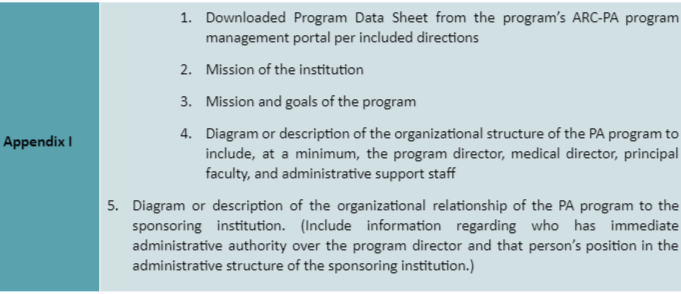BLOG
SCOTT'S THOUGHTS

ARC-PA 5th Edition Standards: Appendix 14 Overview and 14A
For several blogs now we have examined the ARC-PA 5th Edition Standards insofar as how your PA Program can handle the increased demand for data as you create your SSR. I would like now to proceed with unpacking Appendix 14 part by part, to really drill down on the requirements of each section.
In my opinion, the 5th Edition’s Appendix 14 is a definite improvement from the previous rendition. Things have been compartmentalized and streamlined. The differences are:
4th Edition Standards: emphasize modifications being chronicled in Appendix 13 M
5th Edition Standards: require modifications and areas needing improvement to be contained within each new appendix element. This facilitates connectivity between your data analysis, conclusions, and action plans.
Here is a breakdown of the new content by appendix sections. As we can see, in the 5th Edition, modifications and areas needing improvement are in each template, thus they are self-contained. The way in which they are streamlined and connected lends itself to a better way of ensuring that you are clearly connecting your action plans with your narrative. In effect, everybody wins.


Now we’ll begin a section by section review of the requirements.
APPENDIX 14A
Appendix 14A is the timeline for gathering data and analysis, and a template timetable is provided for you. This represents a one-year, annual collection cycle. I dare say that the Commission understands very well the importance of setting up a workable timeline precisely because of the sheer volume of data that it now requires from PA programs. Without a timeline, a functioning PA program could fall into a quagmire of backed-up data within a few weeks.
The requirements for completing 14A itself are fairly straightforward:
Complete the table in the Appendix 14A timeline document, representing your program’s self-assessment process.
The table must include the timing of data collection and analysis. For example, specify “end of each semester,” “annually in August,” and so on as appropriate.
The timing of data collection and analysis may be listed separately as appropriate. An example: Data collected in March-April. Analysis annually in May.
Indicate who is responsible for study of the data, including the job title and/or committee name.
The timeline gives you the opportunity of demonstrating where and when you will be collecting all of the data required throughout the year. Be as specific as possible about when you actually are going to time the data collection. The more specific you are, the better – in answering the requirements of the Commission, and also in preparing your PA program for successful data gathering and analysis.
Next time, we’ll continue this blog series with – what else – Subsection B of Appendix 14, which focuses on the Administrative Aspects and Institutional Resources of your PA program. I’ll share some more examples of concise ways in which your data can be presented with minimum clutter and maximum impact.

ARC-PA 5th Edition Standards: Appendix 14 Overview and 14A
For several blogs now we have examined the ARC-PA 5th Edition Standards insofar as how your PA Program can handle the increased demand for data as you create your SSR. I would like now to proceed with unpacking Appendix 14 part by part, to really drill down on the requirements of each section.
In my opinion, the 5th Edition’s Appendix 14 is a definite improvement from the previous rendition. Things have been compartmentalized and streamlined. The differences are:
4th Edition Standards: emphasize modifications being chronicled in Appendix 13 M
5th Edition Standards: require modifications and areas needing improvement to be contained within each new appendix element. This facilitates connectivity between your data analysis, conclusions, and action plans.
Here is a breakdown of the new content by appendix sections. As we can see, in the 5th Edition, modifications and areas needing improvement are in each template, thus they are self-contained. The way in which they are streamlined and connected lends itself to a better way of ensuring that you are clearly connecting your action plans with your narrative. In effect, everybody wins.


Now we’ll begin a section by section review of the requirements.
APPENDIX 14A
Appendix 14A is the timeline for gathering data and analysis, and a template timetable is provided for you. This represents a one-year, annual collection cycle. I dare say that the Commission understands very well the importance of setting up a workable timeline precisely because of the sheer volume of data that it now requires from PA programs. Without a timeline, a functioning PA program could fall into a quagmire of backed-up data within a few weeks.
The requirements for completing 14A itself are fairly straightforward:
Complete the table in the Appendix 14A timeline document, representing your program’s self-assessment process.
The table must include the timing of data collection and analysis. For example, specify “end of each semester,” “annually in August,” and so on as appropriate.
The timing of data collection and analysis may be listed separately as appropriate. An example: Data collected in March-April. Analysis annually in May.
Indicate who is responsible for study of the data, including the job title and/or committee name.
The timeline gives you the opportunity of demonstrating where and when you will be collecting all of the data required throughout the year. Be as specific as possible about when you actually are going to time the data collection. The more specific you are, the better – in answering the requirements of the Commission, and also in preparing your PA program for successful data gathering and analysis.
Next time, we’ll continue this blog series with – what else – Subsection B of Appendix 14, which focuses on the Administrative Aspects and Institutional Resources of your PA program. I’ll share some more examples of concise ways in which your data can be presented with minimum clutter and maximum impact.
Don't miss out on future events!
Subscribe to our newsletter

© 2025 Scott Massey Ph.D. LLC

